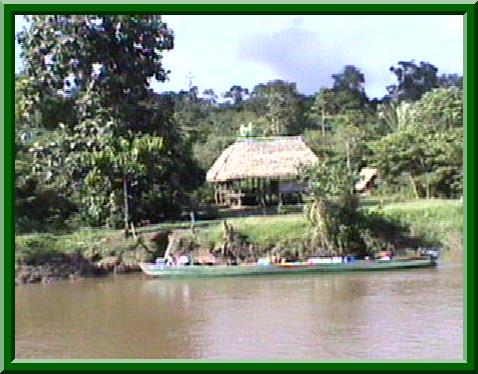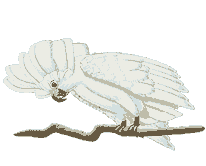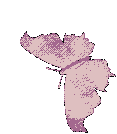THE AMAZON JUNGLE
Page 2 of 3

We safely arrived at the camp. There were bathrooms there, FINALLY!!!! Remember, we first had a two hour ride in the canoes, and then this long walk into the jungle, all right on top of breakfast! We had a great barbecued lunch, of wild boar, at the camp.

After eating, Ed fished for piranha, and I went into the catamarans, still in the pouring rain, looking for birds and other wildlife. You must use binoculars to see anything of birds. The vegetation is very tall and dense. Birds cannot be seen well with the naked eye, and pictures were impossible. We could not dare to take our cameras out of their waterproof containers in the continuous downpours. I must say that the birds I saw were unique and beautiful. Many colorful parrots, macaws, birds with large plumes on their heads, whose names I can't remember, and lots of others whose names I can't remember, either. The butterflies are the most colorful I have ever seen. Ed had some nibbles, but was not able to hook a fish.
 Our
plans had been to swim in the river,even though it
contains those supposedly deadly fish Ed was trying
to catch, and caiman as well, but those plans
were changed by the weather. Caiman feed only at
night, so they do not bother daytime swimmers, and
piranah are, for the most part, vegetarian. They do
not pose a threat. The native people swim, bathe, and
fish in these waters on a daily basis. Another of our
plans was
to sleep at the camp that night, but we changed our
minds when we realized that sleeping on mattresses on
a floor constructed of palm tree trunks, on stilts
above the jungle floor, surrounded by mosquito nets,
would be really difficult for us. Especially with
this weather. We are not
youngsters anymore. A few people in our group did
stay in the camp and told us it was a wonderful
experience. They had seen wild boar, and some large
predatory birds. Instead of sleeping at the camp, we
walked over that same hair-raising boardwalk, and
rode in the dugouts for another two hours, back to
the flotel. As we passed, native
people sat on
the banks of the river and watched us go by. It was
still raining
when we arrived, and again, it was just in time for
dinner.
Our
plans had been to swim in the river,even though it
contains those supposedly deadly fish Ed was trying
to catch, and caiman as well, but those plans
were changed by the weather. Caiman feed only at
night, so they do not bother daytime swimmers, and
piranah are, for the most part, vegetarian. They do
not pose a threat. The native people swim, bathe, and
fish in these waters on a daily basis. Another of our
plans was
to sleep at the camp that night, but we changed our
minds when we realized that sleeping on mattresses on
a floor constructed of palm tree trunks, on stilts
above the jungle floor, surrounded by mosquito nets,
would be really difficult for us. Especially with
this weather. We are not
youngsters anymore. A few people in our group did
stay in the camp and told us it was a wonderful
experience. They had seen wild boar, and some large
predatory birds. Instead of sleeping at the camp, we
walked over that same hair-raising boardwalk, and
rode in the dugouts for another two hours, back to
the flotel. As we passed, native
people sat on
the banks of the river and watched us go by. It was
still raining
when we arrived, and again, it was just in time for
dinner.

After eating, and another briefing about the next day's plans, we went up to the sundeck and watched the stars and listened to the jungle sounds. To our surprise, the boat began to move. It had been repaired while we had been traipsing through the wild terrain. Again today, we had no problem as far as bugs were concerned.
 At 7:00 the next
morning, we
got into the dugouts, still in the pouring rain, with
our ponchos on, and knee-high rubber boots. We
traveled just an hour down the river this time, to a
Cofan village. The Cofans are one of the many native
Indian tribes that live in the jungle. When we
arrived, we were introduced to the bathrooms. One
path for women, and a different path for the men. It
was what they called "Nature's Bathrooms". There was
deep
mud everywhere. When everyone gathered together after
their trip to the 'bathrooms', we went on a jungle
walk with a Cofan guide who introduced us to the
various medicinal plants, and how they use them. It
was VERY
interesting and informative.
At 7:00 the next
morning, we
got into the dugouts, still in the pouring rain, with
our ponchos on, and knee-high rubber boots. We
traveled just an hour down the river this time, to a
Cofan village. The Cofans are one of the many native
Indian tribes that live in the jungle. When we
arrived, we were introduced to the bathrooms. One
path for women, and a different path for the men. It
was what they called "Nature's Bathrooms". There was
deep
mud everywhere. When everyone gathered together after
their trip to the 'bathrooms', we went on a jungle
walk with a Cofan guide who introduced us to the
various medicinal plants, and how they use them. It
was VERY
interesting and informative.

After our walk, we went back to the village, and we saw their various handicrafts. We got to see how they live, how their houses (huts) are constructed, and how the kitchen facilities work. Of course, they, too, use Nature's bathrooms. We also had the opportunity to try out the blowguns they still use to hunt with.
 The thatch roofs on the huts are made from extremely
long palm leaves found in the jungle. These leaves
are 15 feet long, or longer. They are folded in half
at the vein, and tied to roof beams made from slender
tree trunks. They are tied with roots that hang from
the trees. The first leaf is tied down, then the
second leaf is laid half-way over the first, and so
on. This is done much the same way our roofing
shingles are laid. The roofs do not leak. They are
wonderful.
The thatch roofs on the huts are made from extremely
long palm leaves found in the jungle. These leaves
are 15 feet long, or longer. They are folded in half
at the vein, and tied to roof beams made from slender
tree trunks. They are tied with roots that hang from
the trees. The first leaf is tied down, then the
second leaf is laid half-way over the first, and so
on. This is done much the same way our roofing
shingles are laid. The roofs do not leak. They are
wonderful.

The floors of the huts are made from palm tree trunks, cut in half, so they are half-round. When their hut begins to deteriorate, they just cut new lumber, and build a new one.
 The
kitchens have a barbecue type stove. It is a large
metal grate, laid over a raised pit, filled with
charcoal. The steps going
into the huts are made from balsa wood. When a family
goes out, they pick up the steps, which just lean
against the hut, and turn them around backwards, to
let visitors know that no one is home.
The
kitchens have a barbecue type stove. It is a large
metal grate, laid over a raised pit, filled with
charcoal. The steps going
into the huts are made from balsa wood. When a family
goes out, they pick up the steps, which just lean
against the hut, and turn them around backwards, to
let visitors know that no one is home.

The walls are made from bamboo, and are only half-walls, which is evident in the pictures. Some huts now have a solar panel in the thatch roof, which supports one electric light bulb. Most have no electricity at all.
 The villages
are very small.
There are only a few families that live in each
village. The natives dress in typical American
style
clothing,mostly jeans, shorts, and tee-shirts.
They
still dress in their native clothing for ceremonies
and other events that pertain to their culture. We
were not allowed to take pictures here, as the people
really don't want to be 'on display'. Before we left,
we gave a bag of candy to the
children. They
were thrilled with it.
The villages
are very small.
There are only a few families that live in each
village. The natives dress in typical American
style
clothing,mostly jeans, shorts, and tee-shirts.
They
still dress in their native clothing for ceremonies
and other events that pertain to their culture. We
were not allowed to take pictures here, as the people
really don't want to be 'on display'. Before we left,
we gave a bag of candy to the
children. They
were thrilled with it.
![]()